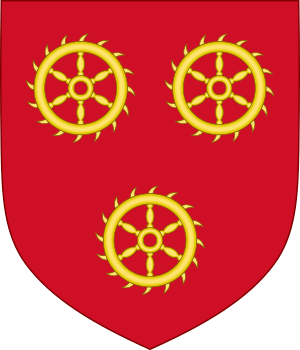Paon de Roet facts for kids

Paon de Roet (born around 1310, died 1380) was a brave herald and knight from Hainaut (which is now part of Belgium). He was involved in the early years of the Hundred Years' War. He became connected to the court of King Edward III of England because the king married Philippa of Hainaut.
Paon de Roet is most famous because he became an ancestor of the future kings and queens of England and Scotland. His daughter Katherine had children with John of Gaunt, who was the king's son. These children were given the last name Beaufort. Katherine's great-granddaughter, Margaret Beaufort, started the Tudor dynasty of English monarchs. Also, Katherine's granddaughter, Joan Beaufort, married into the Stuart dynasty of Scottish monarchs. Another of Paon's daughters, Philippa, also made an important marriage to the famous poet Geoffrey Chaucer.
Contents
Paon de Roet's Life and Work
Early Years and Family Background
Paon de Roet was born around 1310 in Hainaut. He was likely named Gilles, but he became known as Paon or Payne.
Paon de Roet might have been inspired to seek his fortune in England. Another person from Hainaut, Fastre de Roet, went to England in 1326. Fastre joined a group fighting for the English against the Scots. This shows that people from Hainaut often traveled to England for opportunities.
Coming to England
Paon de Roet probably came to England with Philippa of Hainaut. She traveled from Valenciennes to marry the young King Edward III in England in late 1327. His name isn't on the official list of knights who came with the queen. However, a writer named Froissart said that other young knights and squires joined the queen's group.
Froissart's history of English monarchs mentions Paon de Roet. It describes him as "Paon de Rouet of Hainaut, also called Guyenne King of Arms." This means King Edward III gave him the important title of King of Arms for the territory of Guyenne (also known as Aquitaine), which Edward controlled.
Serving in France and Hainaut
In 1347, Paon de Roet was sent to the Siege of Calais. He was one of two knights chosen by Queen Philippa to help the citizens leave the town. These citizens were later known as the Burghers of Calais.
He likely returned to Hainaut by 1349. He went to work for the queen's sister, Marguerite, who was the empress of Germany. His three younger children—Walter, Philippa, and Katherine—stayed in England and were cared for by Queen Philippa. Paon de Roet died in Ghent, County of Flanders, in 1380.
Paon de Roet's Children
Paon de Roet had three daughters: Katherine, Philippa, and Isabel (also called Elizabeth) de Roet. He also had a son named Walter. Isabel became a nun at a convent in Mons in Hainaut around 1366. Philippa married the famous poet Geoffrey Chaucer in 1366. They had met as children while they were part of the household of Elizabeth de Burgh, 4th Countess of Ulster.
Katherine became a governess, teaching the daughters of John of Gaunt. After John's wife, Blanche of Lancaster, died in 1369, Katherine and John had a long-lasting relationship. They had four children together. Later, John married Constance of Castille. After Constance died, John married Katherine and officially recognized their children. These children became important ancestors of the English and Scottish royal families.
Paon de Roet's Tomb
Paon de Roet's tomb was located in Old St Paul's Cathedral in London. It was near the tomb of Sir John Beauchamp. In 1631, a historian named John Weever described the tomb. It was a beautiful marble stone with brass decorations, but by his time, most of the brass was gone.
By 1658, the tomb was described again, still missing its brass parts. Sadly, the tomb was destroyed in 1666 during the Great Fire of London. Many other important tombs, including those of John of Gaunt and Blanche of Lancaster, were also lost. Today, a modern monument in the cathedral's crypt lists de Roet among the important people whose graves were lost.
The inscription on his tomb, as recorded by Weever, began:
- Hic Jacet Paganus Roet miles Guyenne Rex Armorum Pater Catherine Ducisse Lancastrie ...
- (Here lies Paon de Roet, knight, Guyenne King of Arms, father of Katherine Duchess of Lancaster ...)
Historian Alison Weir believes that Katherine herself likely had the tomb made for her father. This would have happened between 1396 and 1403, during her lifetime.


